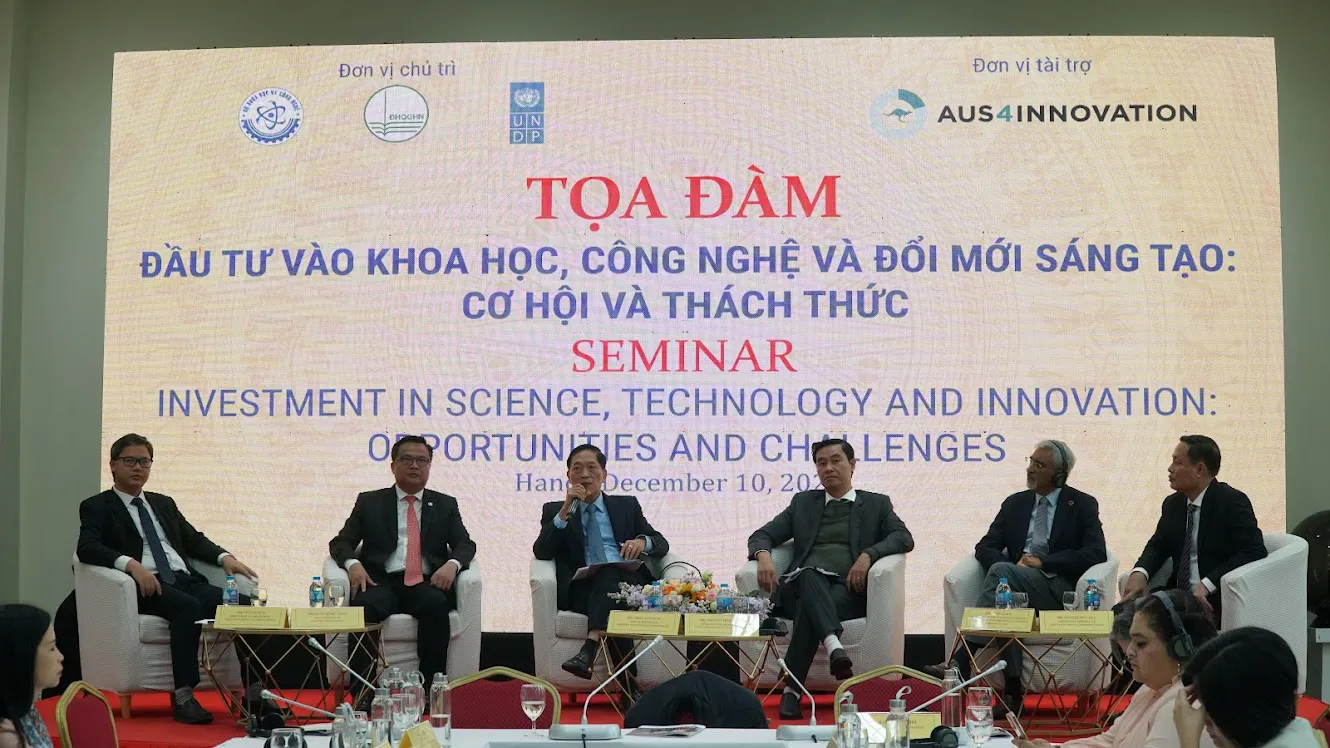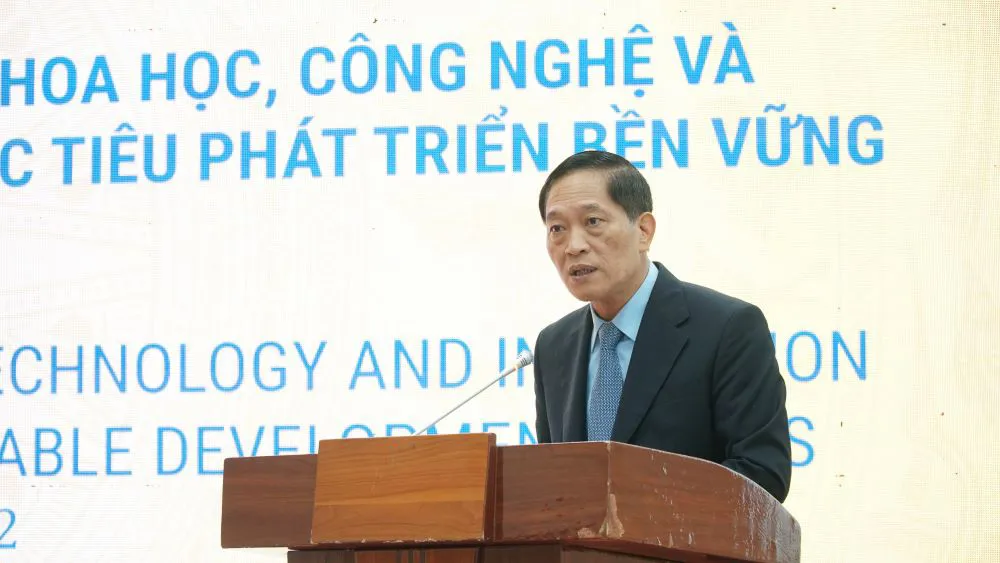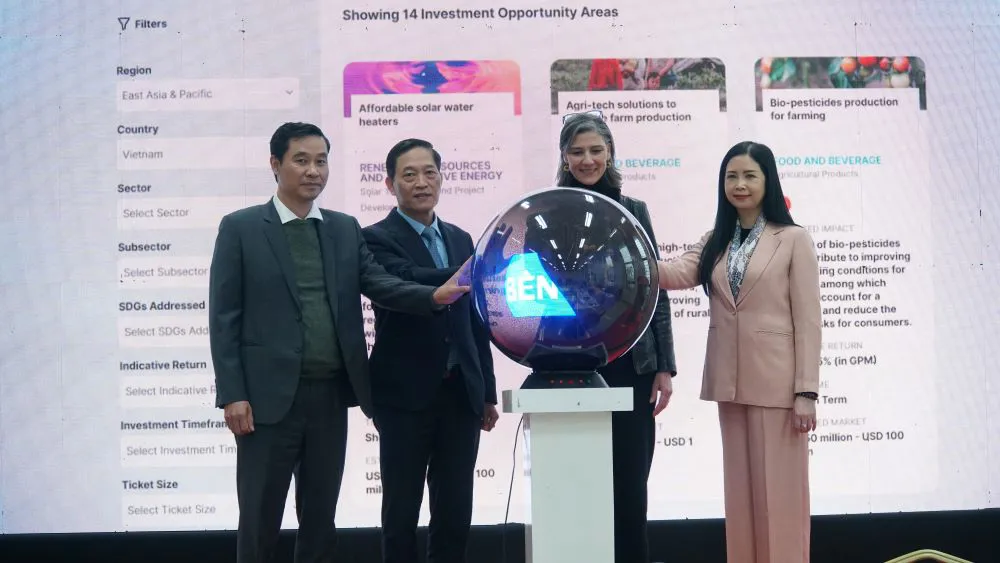Int'l experts seek ways to boost Vietnam's private investment in science, technology
Experts argued that private capital and blended finance investments will continue to be an important component of Vietnam’s sustainable development.
Leading experts from domestic and international agencies and organizations gathered today [December 10] in Hanoi to address challenges facing investment in Vietnam's science and technology as the country's public and private investment in this field is relatively low compared to the world’s average.
| Speakers at the seminar on investment in science and technology held at Hoa Lac Campus, Vietnam National University - Hanoi on Dec 10. Photos: UNDP Vietnam |
The investment rate in this field is around 0.5% of GDP, almost five times lower than the global average sci-tech rate of 2.23%, the figure was released at the conference cohosted by Vietnam’s Ministry of Science and Technology (MOST) and the United Nations Development Program (UNDP) and funded by Australia’s Department of Foreign Affairs and Trade (DFAT).
To increase the rate and facilitate sci-tech investment in Vietnam, policymakers, experts, investors, and businesses explored barriers and opportunities to unlock private investment to accelerate the development and innovation in the country of 100 million people.
The country has enjoyed over three decades of uninterrupted economic growth to become a popular destination for private investors. However, socio-economic challenges remain, and the impact of the Covid-19 pandemic has slowed progress.
Against this backdrop, the Government of Vietnam has made a strong commitment to meet the Sustainable Development Goals (SDGs) by the 2030 Agenda through its National Action Plan 2030. Sci-tech and innovation are considered among the main drivers for socio-economic development in the country, as indicated in many regulatory documents, and are key enablers for achieving the SDGs.
| Tran Van Tung, Deputy Minister of Science and Technology, speaks at the event. |
Necessity
According to experts, unlocking private capital requires robust market intelligence and strong investment relationships.
At the event, participants in the conference shared good international practices to attract private investment in sci-tech and innovation development and exchanged insights about SDG investment areas in Vietnam. At the same time, they mentioned existing and potential barriers that need to be overcome when investing in sci-tech and innovation.
Addressing the event, Tran Van Tung, MOST Deputy Minister, said private investment for science, technology, and innovation has been recently increasing versus public investment. He said the regulatory framework has been strengthened. However, the number of businesses investing in R&D and innovation is relatively low and the usage of sci-tech development funds within businesses is modest.
“Unlocking private investment in sci-tech and innovation development towards sustainable development goals is vital to booster socio-economic development in Vietnam,” he emphasized.
Ramla Khalidi, UNDP Resident Representative in Vietnam, appreciated the strong commitment of the Vietnamese Government to strengthening financial sources to develop science, technology, and innovation.
She offered recommendations on financing science and technology, saying it will be important to nurturing the development of the enterprise sector by promoting state-owned enterprise reforms. Meanwhile, it strengthens the overall business investment environment in terms of competition, access to finance, and administrative requirements.
“A suitably adapted public–private partnership (PPP) pilot program for R&D and innovation could help focus and leverage resources, and improve cooperation between public research and business actors, including foreign firms,” Khalidi noted.
To encourage enterprises of all types of ownership to invest in sci-technology, especially in hi-tech and creative industries and their supporting industries, a range of tax incentives and disincentives should be used to steer investment capital, from both domestic and foreign sources, into these priority areas, she stressed.
| Ramla Khalidi, UNDP Resident Representative in Vietnam, delivers a speech at the event. |
Helpful tool
During the conference, the Vietnam SDG Investor Map (the Map) was launched to provide policymakers, investors, and relevant stakeholders with market intelligence to direct their capital and activity towards SDG-aligned investment themes and business models, known as Investment Opportunity Areas (IOAs).
This serves as a basis for Vietnam to invest in SDG-priority areas to generate profit and consider environmental and social outcomes.
The Map was made possible with support from UNDP SDG Impact’s anchor partner in the ASEAN region and the Center for Impact Investing and Practices (CIIP), a non-profit center established by Temasek Trust.
Dawn Chan, CEO of CIIP, said: “The Vietnam SDG Investor Map provides critical market intelligence for those looking to invest sustainably in the country. It’s an important tool that can be used by private and public sector actors to direct capital to areas of high impact and contribute towards the achievement of the SDGs in Vietnam.”
“The private sector will be a big part of the transformation and the Vietnam SDG Investor Map aims to make it easier for investors to identify and therefore allocate capital to the sectors that will have the most impact,” shared Fabienne Michaux, Director of SDG Impact.
The Map will be used to guide the private sector to where funding is needed most within the country, and they are encouraged to apply sci-tech innovation and efforts to realize the IOAs. Using UNDP SDG Impact’s robust methodology, the Map has identified 14 IOAs across 6 SDG priority sectors that require funding and match the Government’s policies, including Education, Healthcare, Food & Beverages, Infrastructure, Renewable Energy and Financial Services.
The Map also identified 7 white spaces which are IOAs that have growth potential and are aligned with the national development needs, but where Government policies can go further to foster private sector investment participation.
| The launch of the Vietnam SDG Investor Map. |












